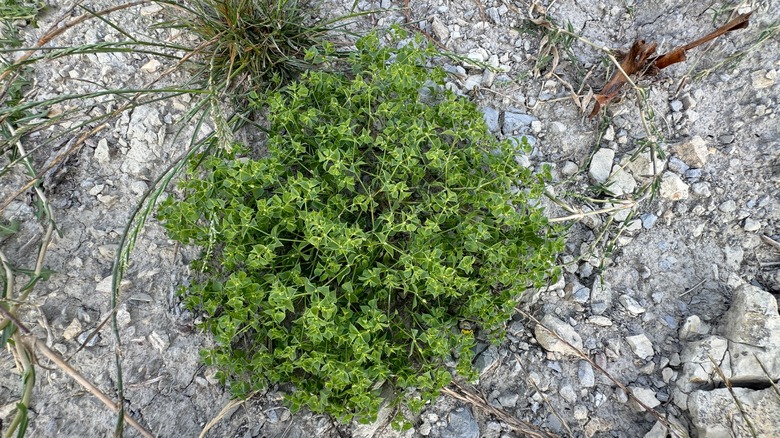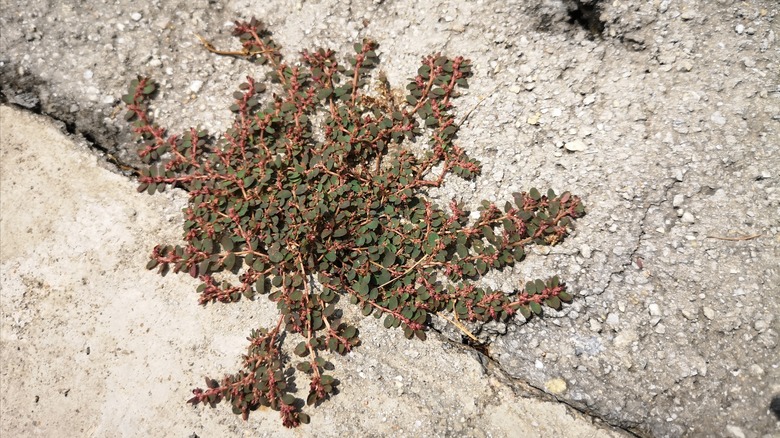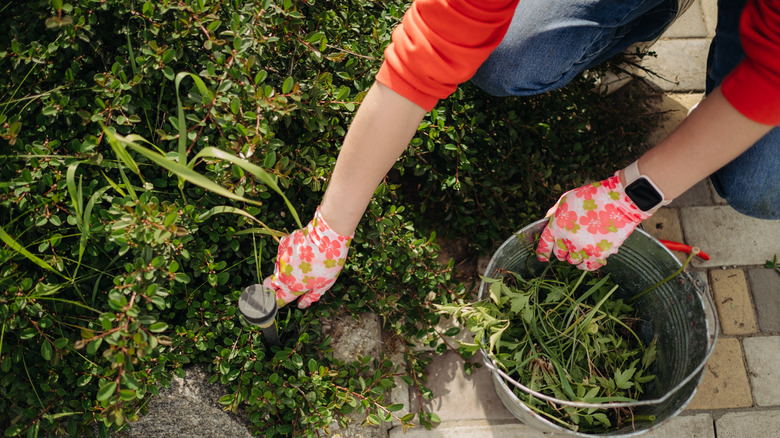The Different Varieties Of Spurge Weed To Be On The Lookout For
Spurge is an invasive weed that's not picky about where it makes its home. While there are more than 2,000 varieties of this plant, a few are more common in the United States than others, and these are the ones you need to look out for. This group includes garden spurge (Euphorbia hirta), creeping spurge, (E. serpens), spotted spurge (E. maculata), and petty spurge, (E.peplus). Given the chance, spurge weeds will invade any accessible area including cracks in your patio or driveway, your lawn and garden beds. Fortunately, these common types of spurge look very similar. If you've ever seen a matted ground weed with thin branching stems and small, dark green leaves in your yard, it may well be a variety of spurge.
As well as being one of the more annoying weeds in your garden, spurge can be a health hazard. All the common varieties of spurge stems contain a milky-white sap that can irritate your skin and your pets' skin. Be careful not to get the sap in your eyes as it may cause temporary blindness, according to the National Capital Poison Center. The first step to getting the upper hand on this troublesome weed is being able to recognize the different varieties.
Name that spurge
An important part of keeping your garden at its best is knowing how to identify common garden weeds. For the most common types of spurge, look for small-leaved weeds with stems that sprout from a central base and spread over the ground. Like its brothers and sisters, garden spurge grows low to the ground with reddish-purple stems that are covered in very fine hairs. Its leaves are dark green, small and oval. Spotted spurge can be easily recognized by dark red spots that appear in the center of the leaves. Its flowers are so tiny that you may barely notice their clusters between the leaves.
Creeping spurge has slightly lighter green leaves that it counterparts, but like them it is an annual and produces tiny white flowers. Petty spurge stands out from the other varieties. Its leaves are much lighter green and instead of creeping along the ground, petty spurge can grow up to a foot in height Like the leaves, its flowers are also pale yellow-green. So now that you know how to spot the different varieties, the next step is knowing how to eradicate spurge before it becomes a regular hanger on.
How to win the spurge war
As with any weed, pulling is the easiest way to remove spurge, though you should wear gloves to protect your hands from the toxic sap. Be sure to pull out the taproot so the stems won't regrow. If you want a little extra help, non-toxic products are among the best products for tackling pesky spurge weed because they will kill the roots. You can also try killing spurge with homemade weed killer with household ingredients. Start with 2 cups of horticultural vinegar. Add 1 ounce of rubbing alcohol, 3 tablespoons of lemon juice, and 2 tablespoons of liquid dish soap. Add to a plastic spray bottle, as vinegar can eat through metal. Shake well, and spray the solution directly onto the spurge leaves, avoiding nearby plants. Don't reapply the weed killer more than once every two weeks.
If the spurge is covering a large section of your yard, an easy way to get rid of it quickly is using the soil solarization method. Cover the area of ground with clear plastic sheets for four to six weeks during the heat of summer. This will heat the top 2 inches of soil to between 108 to 140 degrees Fahrenheit, so spurge won't stand a chance. Not only does this technique kill weeds, it also gets rids of insects and diseases in the soil for up to two to four months. Say goodbye to spurge and hello to a weed-free garden.


